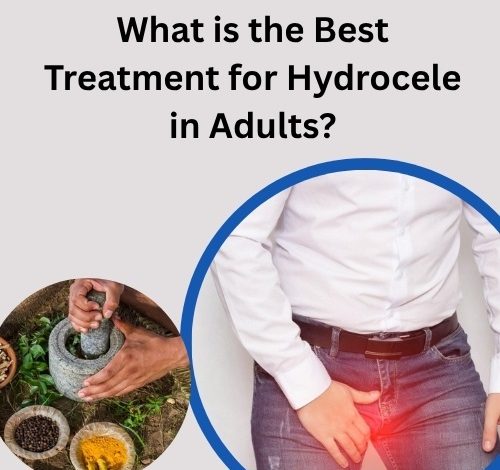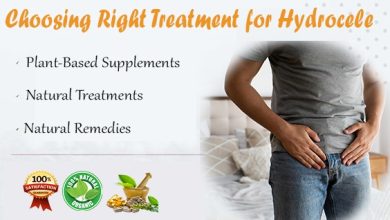What is the Best Treatment for Hydrocele in Adults?

Hydrocele is a common condition in men where fluid collects around the testicle, causing swelling in the scrotum. While it’s usually painless, it can still lead to discomfort, embarrassment, or concern—especially for adults who may not know what’s causing it or how to treat it. If you’re looking for the best hydrocele treatment in adults, you’re not alone.
Clear and practical information on adult hydrocele treatment options, including both surgical and non-surgical methods. Whether you’re hoping to avoid an operation or want to understand your medical choices, this guide aims to help you make an informed decision.
What Causes Hydrocele in Adults?
Hydrocele in adults often results from inflammation or injury within the scrotum. In some cases, it develops due to infection, including sexually transmitted infections (STIs), or secondary to conditions such as epididymitis. Some men develop a hydrocele after surgery on the groin or scrotum, while others may experience it without any obvious trigger.
Although hydrocele in infants often resolves without treatment, adult cases typically require more active management, especially if the swelling persists or causes inconvenience.
Recognising the Symptoms
You might notice:
- Swelling in one or both sides of the scrotum
- A feeling of heaviness
- Discomfort when walking or sitting for long periods
- No sharp pain (though pressure can build over time)
- A soft, fluid-filled sac that you can feel around the testicle
If the swelling appears suddenly or is painful, it’s important to see a doctor quickly, as other issues such as testicular torsion or hernia may have similar symptoms but require urgent care.
Related Article: Malfunctioned Absorption of Fluid Warning Signs Should Not Ignore
Hydrocele Treatment in Adults: Your Main Options
Let’s break down the main adult hydrocele treatment options available today. Each has its pros and cons, depending on your symptoms, age, general health, and preference for surgical or non-surgical methods.
1. Watchful Waiting (Observation)
For many adults, a hydrocele may cause mild symptoms or no bother at all. In such cases, doctors may suggest simply observing it over time. This means regular check-ups to ensure it doesn’t grow or start affecting your daily comfort.
Pros:
- No need for medication or surgery
- Safe and simple
- Suitable for small, painless hydroceles
Cons:
- May increase in size
- Might eventually require treatment
- Can cause emotional discomfort or self-consciousness
If you’re researching hydrocele treatment in adults because you’re unsure whether surgery is necessary, observation is often the starting point—especially if the hydrocele is small and not linked to infection or trauma.
Related Article: Taking Action Against Sexual Abuse: What You Can Do to Help
2. Hydrocele Treatment Without Surgery in Adults: Natural and Non-Invasive Options
Not every adult with a hydrocele wants to undergo surgery straight away. Many prefer to explore hydrocele treatment without surgery in adults first. These options are especially useful for those who can’t undergo surgery due to age, health risks, or personal preference.
- Herbal and Ayurvedic Remedies
Certain herbal treatments may support the reduction of swelling and fluid retention. Though clinical research is limited, traditional systems like Ayurveda suggest herbs that help manage lymphatic fluid and inflammation.
Examples include:
- Punarnava (Boerhavia diffusa) – Known for its diuretic and anti-inflammatory effects
- Gokshura (Tribulus terrestris) – Traditionally used to support urinary and reproductive health
- Shilajit – Often used to improve general male wellness and support detoxification
You can explore more on this by reading our related piece: Hydrocele Treatment Without Surgery in Adults.
Always speak to a qualified practitioner before starting herbal supplements to ensure safety and correct usage.
- Home-Based Support
In mild cases, you might benefit from:
- Wearing supportive underwear
- Elevating the scrotum when sitting or lying down
- Avoiding strenuous activity
- Using anti-inflammatory foods and herbs in your diet
These approaches don’t offer a cure but can improve comfort and support your body’s balance.
3. Needle Aspiration (Temporary Relief)
Needle aspiration involves using a fine needle to drain the fluid from the hydrocele sac. In some cases, a sclerosing agent (a type of chemical) is also injected afterward to prevent fluid from returning.
Pros:
- Quick and simple
- Avoids full surgery
- Can be done under local anaesthetic
Cons:
- Temporary relief—fluid often returns within months
- Can cause infection or recurrence
- Less effective for large or long-standing hydroceles
While needle aspiration may offer short-term relief, it’s usually not a permanent hydrocele adult treatment solution.
4. Hydrocelectomy (Surgical Removal)
Surgical removal remains the most definitive hydrocele treatment for adults. The procedure is known as a hydrocelectomy. It involves making a small incision in the scrotum or lower abdomen and removing or sealing the sac that holds the fluid.
Related Article: Addressing the Causes of Testicular Trauma: How to Reduce Risk
Types of Hydrocelectomy:
- Open hydrocelectomy
- Laparoscopic hydrocelectomy (less common)
Pros:
- Long-term solution
- Low risk of recurrence
- Often done as a day procedure
Cons:
- Recovery time (up to 2–3 weeks)
- Possible complications: infection, bleeding, scrotal swelling
- Requires anaesthesia
Surgery is usually recommended when the hydrocele is large, uncomfortable, or growing. For anyone seeking a durable solution, this often proves the best treatment for hydrocele in adults.
Recovery After Treatment
Post-Surgery Tips
After a hydrocelectomy, you can expect:
- Mild swelling or bruising for up to 2 weeks
- Stitches that may dissolve on their own
- A need to avoid lifting heavy objects or sexual activity for at least 2 weeks
- Use of scrotal support and ice packs to reduce swelling
Follow-up visits ensure the area heals properly and the hydrocele doesn’t return.
Post-Aspiration Care
If you’ve opted for aspiration, you may notice temporary swelling or soreness at the needle site. Keep the area clean, avoid physical strain for 24–48 hours, and wear supportive clothing.
Related Article: How Identify and Treat Blood Blockage Before it Turn to Dangerous
Alternative Medical Approaches
Some doctors may recommend anti-inflammatory medication if pain or inflammation is present. If infection is the cause, antibiotics are prescribed first. However, if the fluid remains even after the infection clears, other treatment may still be needed.
Hydrocele in adults treatment often involves looking at the bigger picture—considering any underlying cause, your age, and your comfort level with different treatments.
Is There a Permanent Solution?
Yes. Surgery provides the most permanent solution. Other approaches such as needle aspiration or herbal support can relieve symptoms or slow progression, but they often don’t offer long-term success without repeated intervention.
That said, many men’s health report improvement using a combination of supportive therapies, especially in the early stages.
Can a Hydrocele Turn into Something Serious?
Generally, no. Hydroceles are usually harmless. However, it’s vital to rule out other conditions like hernias, testicular tumours, or infections. Regular monitoring and medical check-ups can help you stay ahead of any concerns.
Related Article: Interference with Lymphatic Drainage: Strategies to Improve
Frequently Asked Questions
How long does it take to recover from hydrocele surgery?
Most men recover within 2–3 weeks. Some return to light activity sooner, while others need more time depending on the extent of the surgery and individual health.
Can a hydrocele go away on its own?
In adults, this is unlikely. Observation may be suitable for small hydroceles, but many cases will eventually require active treatment.
What’s the success rate of hydrocele surgery?
Hydrocelectomy has a high success rate—over 95% in most studies—with a low chance of recurrence.
Are there any side effects of herbal treatment?
Most herbs are well tolerated when used correctly, but some can interact with medicines or cause side effects. Always consult a healthcare provider before starting.
Related Articles: Types of Hydrocele Explained Clearly: What You Need to Know
Final Thoughts
If you’re dealing with discomfort, swelling, or concern about hydrocele, you have several options to consider. From simple observation and supportive measures to herbal approaches and surgery, the treatment of hydrocele in adults varies based on the cause, size, and impact on your life.
Many men start by exploring hydrocele treatment without surgery in adults before deciding whether further intervention is necessary. Whether you’re aiming for symptom control or permanent relief, there’s a strategy to suit most situations.




